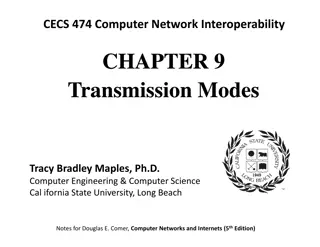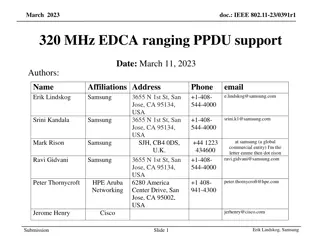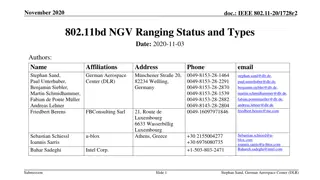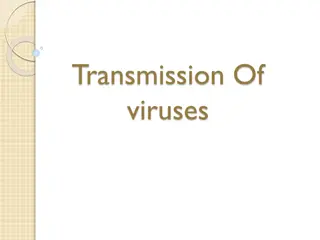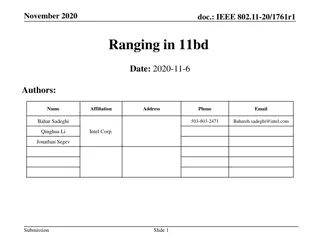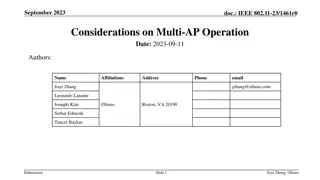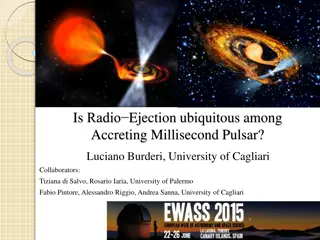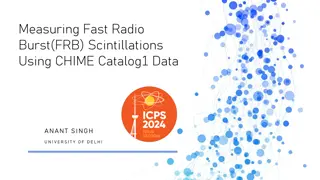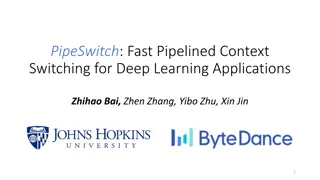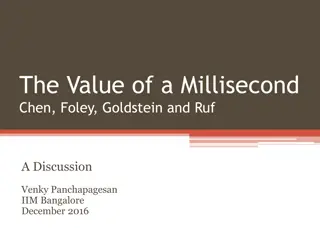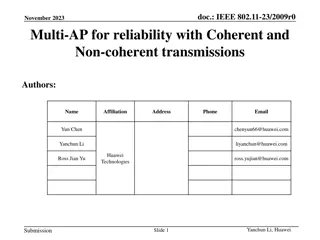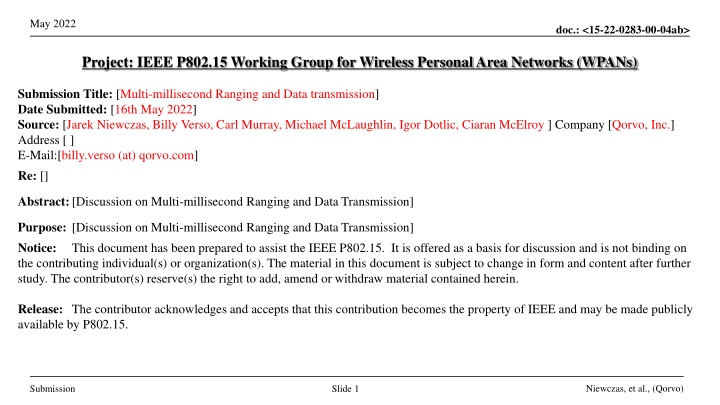
Innovative Multi-Millisecond Ranging and Data Transmission Technique
Explore the cutting-edge Multi-Millisecond Ranging and Data Transmission technique proposed by experts from Qorvo Inc. This technique aims to enhance UWB performance by combining multiple energy sequence fragments, offering improved ranging accuracy, reliability, and sensitivity. Discover the potential for highly reliable data transfer and precise ranging in wireless personal area networks.
Download Presentation

Please find below an Image/Link to download the presentation.
The content on the website is provided AS IS for your information and personal use only. It may not be sold, licensed, or shared on other websites without obtaining consent from the author. If you encounter any issues during the download, it is possible that the publisher has removed the file from their server.
You are allowed to download the files provided on this website for personal or commercial use, subject to the condition that they are used lawfully. All files are the property of their respective owners.
The content on the website is provided AS IS for your information and personal use only. It may not be sold, licensed, or shared on other websites without obtaining consent from the author.
E N D
Presentation Transcript
May 2022 doc.: <15-22-0283-00-04ab> Project: IEEE P802.15 Working Group for Wireless Personal Area Networks (WPANs) Submission Title: [Multi-millisecond Ranging and Data transmission] Date Submitted: [16th May 2022] Source: [Jarek Niewczas, Billy Verso, Carl Murray, Michael McLaughlin, Igor Dotlic, Ciaran McElroy ] Company [Qorvo, Inc.] Address [ ] E-Mail:[billy.verso (at) qorvo.com] Re: [] Abstract: [Discussion on Multi-millisecond Ranging and Data Transmission] Purpose: [Discussion on Multi-millisecond Ranging and Data Transmission] Notice: This document has been prepared to assist the IEEE P802.15. It is offered as a basis for discussion and is not binding on the contributing individual(s) or organization(s). The material in this document is subject to change in form and content after further study. The contributor(s) reserve(s) the right to add, amend or withdraw material contained herein. Release: The contributor acknowledges and accepts that this contribution becomes the property of IEEE and may be made publicly available by P802.15. Niewczas, et al., (Qorvo) Submission Slide 1
May 2022 doc.: <15-22-0283-00-04ab> PAR Objective Safeguards so that the high throughput data use cases will not cause significant disruption to low duty-cycle ranging use cases Interference mitigation techniques to support higher density and higher traffic use cases Other coexistence improvement Backward compatibility with enhanced ranging capable devices (ERDEVs) Proposed Solution (how addressed) Highly reliable and sensitive multi-millisecond ranging. Long- distance data transfer. Improved link budget and/or reduced air-time Additional channels and operating frequencies Improvements to accuracy / precision / reliability and interoperability for high-integrity ranging Highly reliable and sensitive multi-millisecond ranging Reduced complexity and power consumption Hybrid operation with narrowband signaling to assist UWB Ranging options with or without the narrowband-assist Enhanced native discovery and connection setup mechanisms Sensing capabilities to support presence detection and environment mapping Low-power low-latency streaming Higher data-rate streaming allowing at least 50 Mbit/s of throughput Support for peer-to-peer, peer-to-multi-peer, and station-to- infrastructure protocols Infrastructure synchronization mechanisms Niewczas, et al., (Qorvo) Submission Slide 2
May 2022 doc.: <15-22-0283-00-04ab> Multi-millisecond transmission (MMS) UWB energy output is restricted by regulation to 37 nJ per millisecond per 500 MHz This imposes limitations on the UWB performance. To improve ranging performance, in 15-21-0409 and its successors, Ersen et al. proposed a multi- millisecond ranging technique (MMS) combining multiple 37nJ sequence fragments. Niewczas, et al., (Qorvo) Submission Slide 3
May 2022 doc.: <15-22-0283-00-04ab> MMS with/without other PHY-assist - 1 Depending on the application, the technique can be used with or without other-PHY assist. In case of high-sensitivity ranging (attenuated 1stpath), several scenarios may be possible: A. If there is presence of stronger reflections, the energy from the reflected paths can be used to start the UWB reception using standard methods. There is no need for additional assists, however, the weak 1stpath sensitivity could be hugely improved with the MMS technique. Accumulators from consecutive milliseconds can be combined coherently, because the stronger reflection paths will provide phase reference for alignment, even if carrier lock was not maintained during the gaps (and if TX/RX clocks drifted too far). B. When the reflected paths are too weak to start the UWB receiver processing normally, but the UWB receiver is capable of more intensive processing. The receiver could blindly process the incoming UWB signal without knowing the CFO. An example could be a brute-force approach, with multiple parallel accumulators, each testing a different hypothetical CFO. This could allow for coherent accumulation of an UWB fragment and the accumulators from different milliseconds could be later added together. In that case there could be no need for additional assists. C. Alternatively, in a similar situation as (B), the receiver could use support from other PHY by setting the carrier tracking algorithm with correct CFO information. This could allow for simpler coherent accumulation of each fragment, provided that the CFO estimate was sufficiently accurate. Niewczas, et al., (Qorvo) Submission Slide 4
May 2022 doc.: <15-22-0283-00-04ab> MMS with/without other PHY-assist - 2 Scenario (B) can benefit from various optimizations; therefore it could be implementable even in tags: the signal can be shorter (for example 16 s, not 128 s), which significantly reduces the number of candidate CFO s to be processed. the most likely CFO estimate for a particular tag could be known based on previous transmissions. If the crystals are more stable, the potential CFO range could be hugely reduced from the dafault +-40ppm range. The device could buffer up the incoming samples and post-process slowly during the silence gap In scenarios (B) and (C), since the clocks may drift unpredictably during the silence gap, subsequent MMS accumulators may need to be combined non-coherently (unless each of them contains sufficient multi-path energy to be used as phase reference). However, even non-coherent MMS combining provides pretty high gains. Niewczas, et al., (Qorvo) Submission Slide 5
May 2022 doc.: <15-22-0283-00-04ab> MMS data transmission in UWB - 1 The MMS technique can also be applied to data transmission. While the data payload can be split and sent in separate packets using 802.15.4z techniques, the MMS will offer better performance. Scenarios: data payload is too large to fit into the single UWB block (e.g. >4095 bytes). the combination of payload size and the range required cannot be realized using a single 37 nJ energy budget. In 802.15.4z, the energy budget is shared between the SYNC/SFD part and the PHR/DATA parts. While some re-balancing of the packet energy with different SYNC length(s) and DATA rate(s) may be possible to increase the overall range, only a relatively small improvement can be obtained this way. Assuming 30-byte payload, shorter 48-symbol SYNC and SFD8, the hypothetical new PRF128 modes could offer +1.3dB (3.9Mbps) or +2.1dB (1.9Mbps) of additional sensitivity relative to 4z s 7.8Mbps. The 3.9Mbps at PRF256 would be also +2.1dBs. With MMS, SYNC/SFD can be sent in the separate millisecond than data (data at a rate 7.8Mbps): With the same 30-byte payload in a separate fragments, sensitivity increases by +3.5dB compared to 4z s 7.8Mbps If the 30-byte payload is sent in two fragments (2x15-bytes), sensitivity increases by +6.5dB compared to 4z s 7.8Mbps Since the SYNC does not share any energy with data, its detection performance is also significantly improved. Niewczas, et al., (Qorvo) Submission Slide 6
May 2022 doc.: <15-22-0283-00-04ab> MMS data transmission in UWB - 2 The UWB receiver would be started and prepared for data during the 1stfragment (SYNC/SFD). That includes CFO estimation and the channel measurements (for data demodulation). The SFD identifies the signal arrival time within 1-symbol. After the SYNC has been processed, the receiver expects data in the next fragment. At walking speeds and considering the wavelength, the channel change between millisecond fragments will be insignificant (including relative phase differences between multi-paths), therefore the channel state information obtained during the SYNC could be used for data demodulation. However, the timing drift (due to CFO and length of the gap) will need to be compensated for. The complex phase of the data signal in the next DATA fragment wil change due to insufficient CFO estimation accuracy and/or clock instabilities. To rapidly align the receiver phase before demodulation, DATA fragments should start with a short pilot sequence. Niewczas, et al., (Qorvo) Submission Slide 7
May 2022 doc.: <15-22-0283-00-04ab> MMS data transmission in UWB - 3 The receiver needs to be configured for such MMS packets with some information: length of the gap payload length and the number of fragments The configuration could be: signalled ahead in previous UWB packets or via other PHY in PHR-like sequence attached at the end of the 1st(SYNC) fragment and/or additionally in PHR field before each new data fragment Niewczas, et al., (Qorvo) Submission Slide 8
May 2022 doc.: <15-22-0283-00-04ab> Conclusion The multi-millisecond (MMS) UWB techniques could be implemented with or without other-PHY assist. The MMS could be applied to both ranging and data for increased sensitivity. Niewczas, et al., (Qorvo) Submission Slide 9



